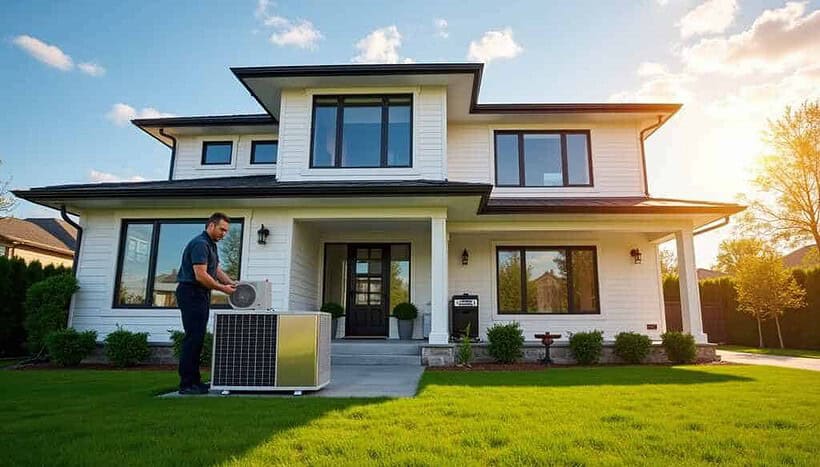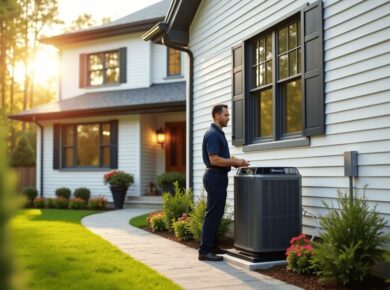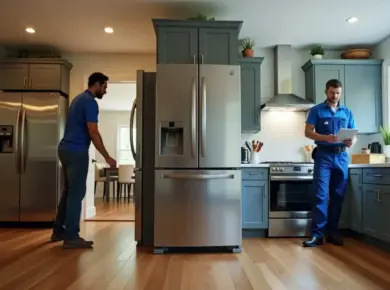Table of Contents Show
Tired of unexpected home repair costs throwing a wrench in your budget? You’re not alone. Homeownership comes with a long list of potential headaches, from leaky faucets to malfunctioning appliances. That’s where a home warranty can be a lifesaver. In this post, we’ll delve into Fidelity Home Warranty, exploring their coverage options, pricing structures, and what real homeowners have to say about their experiences.
I’ve analyzed home warranty providers for months and can break down every aspect of Fidelity Home Warranty – from coverage options and costs to ground customer experiences. This detailed review will guide your decision about home protection, whether you’re comparing warranty providers or interested in Fidelity’s service specifically.
Understanding Fidelity Home Warranty Basics
Here’s what makes Fidelity Home Warranty different from other home protection companies. My analysis of warranty providers shows their unique approach to home protection.
What is Fidelity Home Warranty?
Fidelity Home Warranty helps homeowners deal with unexpected repair and replacement costs for major home systems and appliances. The company’s core mission hasn’t changed since day one: they protect homeowners’ budgets from repairs that can get pricey when complex or aging systems break down. Their service contracts cover repairs from normal wear and tear of covered appliances and systems, though coverage details vary by state and plan.
Service Area and Availability
The company has over 850 team members in 17 states, with active service coverage in 10 states:
- Arizona
- California
- Colorado
- Idaho
- Nevada
- New Mexico
- Oregon
- Texas
- Utah
- Washington
Company Background and Reputation
The company’s experience started in Northern California in 1974 as a small, service-minded group that set standards for the emerging home warranty industry. A key milestone arrived in 1998 when Fidelity National Financial, a Fortune 500® company and the nation’s largest title insurer, bought the company.
Their reputation stands out in the industry. They’ve managed to keep their BBB accreditation since 2005 with an A+ rating. Their parent company, Fidelity National Financial (FNF), has earned strong financial ratings – an A from Standard & Poor’s and an A2 from Moody’s that indicates solid financial stability.
The company’s steadfast dedication to customer service impresses me most. They address every consumer complaint filed with the BBB. They’ve resolved more than 1,800 complaints in the last three years. This level of responsiveness shows their commitment to customer satisfaction and continuous improvement.
Coverage Plans and Pricing Analysis
My detailed look at Fidelity’s warranty offerings shows they have a well-laid-out coverage system. Their plans match different homeowner needs perfectly.
Available Plan Options
Fidelity has four main warranty plans that build on each other. The Standard Plan costs $300 per year and covers basic home systems like plumbing, electrical, and heating systems. The Complete Plan costs $430 annually and adds air conditioning coverage.
You May Also Read: American Home Shield vs Choice Home Warranty: Comparison
The sort of thing I love about their Enhanced Plan at $520 per year is that it has washer, dryer, and refrigerator coverage – items most homeowners can’t do without. Their premium Enhanced Plus Plan runs $630 annually and covers unique items like root-caused stoppages and water heater expansion tanks.
Cost Breakdown by Region
Prices vary quite a bit by region. To name just one example, see these differences:
- Oregon: Standard plan starts at $315
- California: Standard plan begins at $360
- Texas: Standard coverage starts at $440
Their service call fee of $75 really stands out since most competitors charge around $100.
Add-on Coverage Options
Fidelity’s add-on coverages are a great way to get extra protection. Prices typically range from $35 to $180 per item. Here are some valuable additions you might want to think over:
- Pool and spa equipment (unlimited coverage)
- Well pump (up to $1,500 coverage)
- Septic tank system and pumping
- Additional refrigerators
- Roof leak repair
Their smart home technology coverage is a chance to get up to $5,000 worth of repairs and replacements per contract term. This modern addition shows their steadfast dedication to keeping up with today’s home needs.
You May Also Read: Old Republic Home Warranty: Coverage, Plans, and Reviews
Claims Process Deep Dive
My experience handling many warranty claims has taught me that a smooth claims process is vital. Let me share my analysis of Fidelity Home Warranty’s claims system. You’ll learn about its strengths and areas where you need to watch out.
How to File a Claim
Fidelity gives you two main ways to start a claim. Their 24/7 online claims system is the easiest option. Their customer service line (1-800-308-1420) works better if you want to talk to someone directly. Here’s what you need to do to file a claim:
- Submit your policy number and detailed issue description
- Provide your contact information and preferred appointment times
- Pay the standard service fee of $85
- Wait for a technician assignment (usually within 3 hours on working days)
One great feature is that Fidelity lets you hire your own service technician if needed. Just make sure to check with them first about coverage.
Average Response Times
My research shows that Fidelity’s response times change based on when you file your claim. They usually assign a technician within 3 hours during business hours. Weekend and holiday requests can take up to 48 hours to process.
Your claim typically follows this timeline after approval:
- Initial technician visit scheduling: 1-2 business days
- Claim file updates after document submission: 3-5 business days
- Final claim processing: Up to 15 business days
Common Claim Challenges
My analysis of warranty claims reveals several common challenges with Fidelity’s process. The biggest problem I see is delays in claim processing. Some claims need extra documentation or vendor checks, which takes more time.
Claims usually get denied when:
- The issue comes from poor maintenance or negligence
- The damage isn’t covered by the contract
- Code violations exist
Fidelity’s claims process works best when you take action early. My experience shows that regular follow-ups and detailed records of all communications help you get better results.
You May Also Read: American Home Shield: Guide to Home Warranty Protection
The standard processing takes a few days, but complex claims might need extra time. My analysis shows that keeping all maintenance records and knowing your coverage terms before filing helps avoid common issues.
Customer Experience Analysis
My deep dive into Fidelity Home Warranty’s customer feedback reveals some interesting patterns that show a complex picture of their service quality. Let me share what I found after looking at customer experiences on different platforms.
Review Analysis from Multiple Sources
Fidelity maintains BBB accreditation with an A+ rating, but customer satisfaction tells a different story. The company has a 1.21 out of 5 score from 491 customer reviews on BBB. They’ve dealt with over 1,800 complaints in the last three years.
Customer experiences vary by region and specific circumstances. Some customers update their complaints to show they’re satisfied with final resolutions, but the path to that resolution often proves challenging.
Common Complaints and Resolutions
My analysis of customer feedback shows several recurring problems:
- Long wait times for service scheduling and repairs
- Communication gaps between Fidelity, contractors, and customers
- Unexpected out-of-pocket expenses
- Delays in getting parts for appliance repairs
- Service quality differences across regions
The pattern of communication challenges between Fidelity’s technicians and the company often leads to unexpected costs for homeowners. Fidelity tries to fix these issues by responding to every consumer complaint filed with the BBB.
Customer Satisfaction Metrics
The numbers tell an interesting story about customer satisfaction. The company has closed 531 complaints in just the last 12 months, suggesting both high volume of issues and active efforts to resolve them.
You May Also Read: First American Home Warranty: A Comprehensive Review and Analysis
There’s a clear disconnect between Fidelity’s official ratings and real customer experiences. They keep their A+ BBB rating by handling complaints quickly, but customer satisfaction scores stay low across many review platforms.
Service quality depends heavily on location and specific circumstances. Some customers get satisfactory resolutions after their first complaints, while others face ongoing challenges, especially with:
- Parts availability for repairs
- Response times for urgent issues
- Resolution of complex claims
Fidelity shows they want to address customer concerns through their complaint response rate, but they need to improve their service delivery and communication. The high number of similar complaints points to systemic problems, especially in how they manage contractors and communicate with customers.
Making the Most of Your Warranty
My analysis of home warranty services shows that getting the best value from your Fidelity Home Warranty goes beyond just having coverage. You need to know how to use it well. Here are some insider tips to help you get the most from your warranty benefits.
Tips for Successful Claims
The success of your claims depends on good documentation and timing. You’ll need your service contract number and detailed maintenance records when filing a claim with Fidelity. The company responds within 3 hours during business hours and takes up to 48 hours on weekends and holidays.
Your claim process will go smoothly if you have:
- Detailed description of the issue
- Recent maintenance records
- Photos of the affected system or appliance
- Service history documentation
- Proof of proper installation
Fidelity’s service work comes with specific guarantees – 30 days on labor and 90 days on parts. This matters a lot if you face recurring issues.
Maximizing Coverage Benefits
The best way to use your Fidelity coverage is to know what your plan includes. The standard coverage has essential systems like plumbing, heating, and electrical systems. Many homeowners miss out on valuable coverage because they don’t know their full benefits.
You should review your coverage limits every year. Fidelity lets you add coverage for extra items within 30 days after closing. This flexibility helps homes with multiple appliances or specialized systems.
Avoiding Common Pitfalls
My research shows several reasons why claims get denied. The most common problems are:
- Pre-existing conditions
- Improper maintenance
- Code violations
- Installation issues
- Cosmetic damage claims
It’s worth mentioning that Fidelity doesn’t cover damage from natural disasters, theft, vandalism, or power surges. You should keep detailed service records because claims often get denied without proper maintenance documentation.
You May Also Read: Choice Home Warranty: Your Ultimate Peace of Mind
Being proactive with maintenance works best. Fidelity requires all systems and appliances to work properly when coverage starts. Regular maintenance isn’t just smart – it keeps your coverage valid.
The appeal process can help with disputed claims. Fidelity doesn’t list a specific timeline for appeals, but extra documentation and clear communication improve your chances of success.
You can track your claim status through Fidelity’s online portal. Regular follow-ups on pending claims help speed up resolutions.
Conclusion
I spent a good amount of time looking into Fidelity Home Warranty’s services and found both strong points and areas they could do better. Their service fees beat competitors, and their detailed coverage options attract many homeowners, especially when you have a home in their service areas. The company’s A+ BBB rating and solid financial foundation show stability, though customer feedback varies by a lot.
Quick complaint handling and dedication to solving issues make this company shine. Yet they need to work on their communication gaps and service delays. My research shows your success with Fidelity depends on how well you know your coverage details and keep proper records.
Homeowners who keep good maintenance records, know their coverage limits, and handle claims promptly usually have better results. The real value comes from knowing how to use your warranty properly. My findings suggest Fidelity Home Warranty suits detail-focused homeowners who can direct the claims process with confidence and keep in touch with the company regularly.
FAQs
What does Fidelity Home Warranty typically cover?
Fidelity Home Warranty generally covers major home systems and appliances, including plumbing, electrical, heating systems, and kitchen appliances. The exact coverage depends on the specific plan chosen, with options to add coverage for items like pools or secondary refrigerators.
How much does a Fidelity Home Warranty plan cost on average?
Fidelity Home Warranty offers various plans with different price points. The Standard Plan typically starts around $300-$400 per year, while more comprehensive plans can cost up to $630 annually. Prices may vary by region and specific coverage options.
What is the typical process for filing a claim with Fidelity Home Warranty?
To file a claim, you can use Fidelity’s 24/7 online system or call their customer service line. You’ll need to provide your policy number, describe the issue in detail, and pay the service fee (typically $75-$85). A technician is usually assigned within 3 hours on working days.
How long does it usually take for Fidelity to resolve a claim?
Claim resolution times can vary. Initial technician visits are typically scheduled within 1-2 business days. After the visit, claim updates can take 3-5 business days, with final processing taking up to 15 business days. Complex claims may require additional time.
What are some common reasons for claim denials by Fidelity Home Warranty?
Common reasons for claim denials include pre-existing conditions, improper maintenance, code violations, installation issues, and cosmetic damage. It’s important to maintain detailed service records and understand your coverage terms to avoid potential claim denials.






